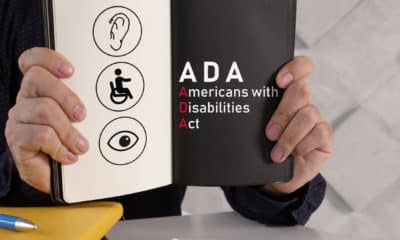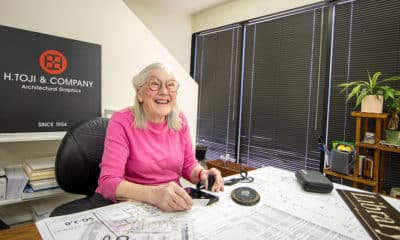ADA Signs
Wayfinding Is Not Signage
Published
18 years agoon
Even though signage plays an important role in wayfinding, the process doesn't rely exclusively on signs.
The term "wayfinding" was first used in 1960 by architect Kevin Lynch in The Image of the City, where he referred to maps, street numbers, directional signs and other elements as "way-finding" devices. This narrow description may explain the current misunderstanding that wayfinding is essentially the same as "signage."
The two terms are not synonymous. Signmakers deal with designing, fabricating and installing signs. However, wayfinding used to navigate unfamiliar environments, doesn't rely exclusively on signs.
This distinction gained acceptance in the early '70s when researchers discovered that, to understand how people find their way, they first need to understand the underlying process. Architect and environmental psychologist Romedi Passini articulated spatial problem-solving in his books, Wayfinding in Architecture and Wayfinding, People, Signs and Architecture, which he co-authored with wayfinding planner Paul Arthur.
Passini and Arthur described wayfinding as a two-stage process during which people must solve a wide variety of problems in architectural and urban spaces that involve both "decision making" (formulating an action plan) and "decision executing" (implementing the plan).
People who find themselves in unfamiliar environments need to know where they actually are in the complex, the layout of the complex, and the location of their destination in order to formulate their action plans. En route to their chosen destinations, people are helped or hindered prior to their visit, the building's architecture and signage. The physical environment, including positive effect in how users perceive the wayfinding system–if it seems easy to use or not.
AdvertisementFaulty sign design can cause navigation problems in unfamiliar environments. Some signs lack "conspicuity," or visibility, because lettering lacks legibility when viewed from a distance. Others contain inaccurate, ambiguous or unfamiliar messages; many are obscured by obstructions or contain reflective surfaces, which hinder comprehension. Consequently, many people don't read signs–often it's easier to ask for directions.
Because wayfinding problems aren't confined to signs alone, they typically can't be solved by adding more signs. Instead, such problems can be unraveled by designing an environment that identifies logical traffic patterns that enable people to move easily from one spot to another without confusion. Signs cannot be a panacea for poor architecture and illogical space planning.
Four elements
Wayfinding needs are best resolved during initial planning stages through a collaborative effort by all design professionals–architects, designers and signmakers–to address a project's total environmental communication. The primary generator of environmental communication, architecture delineates spatial organization, destination zones and information sequencing–factors that spell wayfinding's success or failure. Effective architectural wayfinding clues, provided by roads, building layouts, corridors and lighting, furnish cognitive maps that allow people to quickly grasp the environment. To furnish architectural clues:
- Clearly identify arrival points.
- Provide convenient parking and accessible walkways located adjacent to each public entry.
- Locate information desks within each public entry visible from the front door.
- Place elevator lobbies so they can be seen upon entering the building.
- Use consistent lighting, floor coverings and architectural finishes in primary public corridor systems.
- Situate memorable landmarks along corridors and at key decision points.
- Design public waiting areas that are visually open to corridors.
- Distinguish public from non-public corridors by using varied finishes, colors and lighting
- Harmonize floor numbers between connecting buildings.
Graphic communication
Graphics, such as signs, color coding, maps, banners, brochures and Websites, provide orientation, direction, identification and regulatory information. To achieve effective graphic communication:
Advertisement- Standardize names for all buildings, services and destinations, and display them consistently on all graphics applications.
- Use easily understood "plain" language.
- Size messages and signs appropriately for viewing distances.
- Select letterforms and color combinations that comply with Americans with Disabilities Act (ADA) Accessibility Guidelines
- Furnish generous spacing between letters, words and message lines.
- Provide standardized "you are here" maps of the project that include an overall map of the complex and more detailed maps of specific areas.
- Train attendants to mark individualized paths on hand-held maps for lost or disoriented visitors.
- Place maps at all parking exits, building entrances and major interior decision points.
- Orient maps with building layouts, such as denoting on maps that "up is ahead."
- Establish consistency in sign placements and graphics layouts.
- Code areas by using color and memorable graphics.
- Use established pictographs with words to facilitate comprehension of written messages.
- Establish a floor numbering system that relates to a building's main entry and indicate on directories which floors are above and below grade.
Audible communication
Audible communication, as interpreted through verbal instructions, PA systems, elevator chimes and water fountains, plays an important role in wayfinding. Recognizing that 50% of the American population is functionally illiterate (according to a recent study published by the U.S. Department of Education) and that another 15% possess other perceptual or cognitive impairments, audible communication fills an important role in any wayfinding solution. To establish effective audible communication:
- Install audible sounds at signaled intersections to indicate safe times to cross the street.
- At all public entries and information desks, provide attendants trained as professional greeters who are thoroughly familiar with the facility.
- Furnish self-help telephones at all information desks.
- Provide patient-transport personnel whose purpose is to guide visitors to their destinations.
- Standardize names for all buildings, services and destinations, and use them consistently in verbal communication.
- Equip elevators with audible chimes.
- Position audible landmarks, such as water fountains, at waiting areas.
- Employ audible signs to help locate information desks, elevators, rest rooms and other key destinations.
Tactile communication
Tactile communication, achieved by raised letters, Braille, knurled door knobs and textured floor coverings assists all visitors, not only the disabled. To incorporate tactual devices into a wayfinding system:
- Establish "shorelines" and "trails" between major destinations and information areas using materials having differing resiliency's, such as concrete and carpet.
- Install "rumble strips" at the landings of stairs and escalators.
- Furnish knurled door knobs at all non-public doors.
- Provide a raised star symbol on elevator control panels to indicated the ground floor.
- Supply raised letters and Grade 2 Braille at elevators and on signs identifying permanent destinations.
- Install interactive audio-tactile maps at public entrance lobbies.
Consistent clues
Architects, designers and signmakers must work together from the beginning of a project to create a total environmental statement that provides consistent clues. So, the next time a client asks for wayfinding signage. tell them that wayfinding is not signage–it's more.
AdvertisementSPONSORED VIDEO
Introducing the Sign Industry Podcast
The Sign Industry Podcast is a platform for every sign person out there — from the old-timers who bent neon and hand-lettered boats to those venturing into new technologies — we want to get their stories out for everyone to hear. Come join us and listen to stories, learn tricks or techniques, and get insights of what’s to come. We are the world’s second oldest profession. The folks who started the world’s oldest profession needed a sign.
You may like
Advertisement
Subscribe

Magazine
Get the most important news
and business ideas from Signsofthetimes Magazine.
Advertisement
Most Popular
-

 Tip Sheet1 week ago
Tip Sheet1 week agoAlways Brand Yourself and Wear Fewer Hats — Two of April’s Sign Tips
-

 Photo Gallery2 days ago
Photo Gallery2 days ago30 Snapshots of the 2024 ISA Sign Expo
-

 Ask Signs of the Times4 days ago
Ask Signs of the Times4 days agoWhy Are Signs from Canva so Overloaded and Similar?
-

 Real Deal1 week ago
Real Deal1 week agoA Woman Sign Company Owner Confronts a Sexist Wholesaler
-

 Benchmarks6 days ago
Benchmarks6 days ago6 Sports Venue Signs Deserving a Standing Ovation
-

 Women in Signs1 week ago
Women in Signs1 week ago2024 Women in Signs: Megan Bradley
-

 Photo Gallery1 week ago
Photo Gallery1 week ago21 Larry Albright Plasma Globes, Crackle Tubes and More
-

 Women in Signs1 week ago
Women in Signs1 week ago2024 Women in Signs: Ashley Borell








